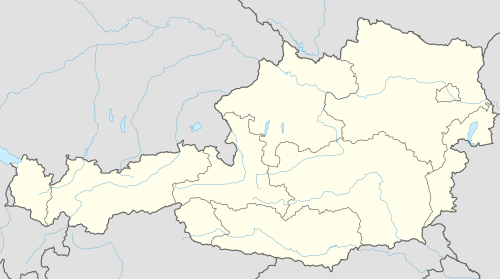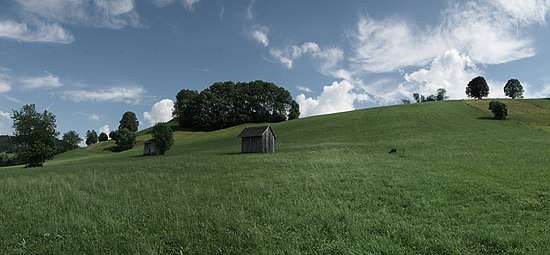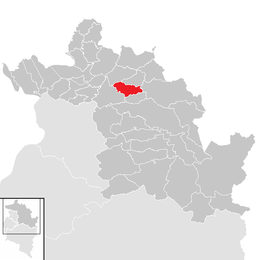Langenegg
| Langenegg | ||
|---|---|---|
|
| ||
| ||
 Langenegg Location within Austria
Location in the district
| ||
| Coordinates: 47°28′05″N 09°53′49″E / 47.46806°N 9.89694°ECoordinates: 47°28′05″N 09°53′49″E / 47.46806°N 9.89694°E | ||
| Country | Austria | |
| State | Vorarlberg | |
| District | Bregenz | |
| Government | ||
| • Mayor | Kurt Krottenhammer | |
| Area | ||
| • Total | 10.46 km2 (4.04 sq mi) | |
| Elevation | 700 m (2,300 ft) | |
| Population (1 January 2016)[1] | ||
| • Total | 1,147 | |
| • Density | 110/km2 (280/sq mi) | |
| Time zone | UTC+1 (CET) | |
| • Summer (DST) | UTC+2 (CEST) | |
| Postal code | 6941 | |
| Area code | 05513 | |
| Vehicle registration | B | |
| Website | www.langenegg.at | |
Langenegg is a municipality of 1125 inhabitants (as of 1 January 2015) which is in the Austrian province of Vorarlberg.
Geography
Langenegg is located in the Bregenz Forest the westernmost province of Austria, Vorarlberg, in district of Bregenz southeast of Lake Constance. It covers an area of 10.47 km², 38.6% of which is forested and 54.6% is used for agricultural purposes. Geographically, the municipality forms a "long corner", hence the name Langenegg (German: Egg ≈ Eck(e) = corner). The municipality is a member of the German-Austrian joint project Nagelfluhkette National Park.
Neighbouring communities
The municipality of Langenegg borders five other municipalities in Vorarlberg. These communities, also located in the Bregenz Forest, are clockwise from the north: Doren, Krumbach, Hittisau, Lingenau and Alberschwende.
History
The Habsburgs ruled the cities in Vorarlberg partly from Tyrol and from Further Austria. From 1805 to 1814 it belonged to Bavaria, then back to Austria. Langenegg was part of Vorarlberg since its founding in 1861. The place was part of the French occupation zone from 1945 until 1955. On July 6, 2010 Langenegg won the competition for the 11th European Village Renewal Award.
Coat of arms
The municipal coat of arms was created by the Schrunser artist and heraldist Konrad Honold in 1969.
Population
| Historical population | ||
|---|---|---|
| Year | Pop. | ±% |
| 1869 | 1,049 | — |
| 1880 | 1,010 | −3.7% |
| 1890 | 908 | −10.1% |
| 1900 | 1,003 | +10.5% |
| 1910 | 808 | −19.4% |
| 1923 | 838 | +3.7% |
| 1934 | 798 | −4.8% |
| 1939 | 712 | −10.8% |
| 1951 | 763 | +7.2% |
| 1961 | 718 | −5.9% |
| 1971 | 705 | −1.8% |
| 1981 | 807 | +14.5% |
| 1991 | 972 | +20.4% |
| 2001 | 1,026 | +5.6% |
| 2011 | 1,070 | +4.3% |
The proportion of foreigners in 2002 was 7.1%.

Politics
The Langeneggian municipal council consists of 15 members. The election took place during the last local council elections in 2015 not by party lists, but by majority vote. Mayor of the municipality is Kurt Krottenhammer.
Economy and infrastructure
In 2003, there were 16 enterprises of trade and industry with 92 employees and four apprentices. There were 429 wage taxpayers in employment. Agriculture plays an important role. The share of agricultural land in the total area is 54.6%. There are 42 farms, of which 35 are dairy farms. 2.6 million kilograms of milk are processed annually in the Langenegger dairy. The cheese factory produces 250 tons of cheese each year. In order to transport the milk to the dairy, three cable tracks are in use.
During the industrialisation in Langenegg, the number of commuters working in the neighbouring municipalities increased. Unlike many municipalities in the region, Langenegg did not have a rich structure with regard to craft associations. That is why in the last few years, the municipality gave rise to numerous economic initiatives such as the "Talent", the Langenegger currency that supports business in the village.
Education
There is a school with 107 students (as of November 2006) and a small kindergarten.
Culture
The Hubertus chapel at Hälisbühl was built in 1992.
The parish church "Unserer lieben Frau" (Maria) was built in 1775 in Baroque style.
The Bregenzerwald Umgang (literally "Bregenz forest walk") shows the design of 12 traditionally built villages, including Langenegg, in the Bregenz Forest. By means of the landscape, public buildings, houses and everyday objects walkers are informed about the typical Bregenzerwälder architecture style through the ages.
The Sennerei Langenegg (dairy Langenegg) is a 1978 fusion of three dairies, which were built in 1900, 1947 and 1952. This dairy has 30 suppliers for milk (with about 450 cows) and is part of the Käsestraße Bregenzerwald – a partnership of farmers, milkmen, artisans and gastronomists in the Bregenzerwald with the aim of small-scale agriculture, the diversity of local products and the Vorarlberg cheese culture.

External links
References
| Wikimedia Commons has media related to Langenegg. |

